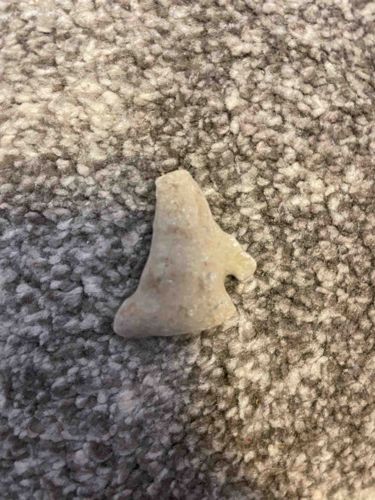
Irregularly Shaped Pale Stone Geofact
The item appears to be a small, irregularly shaped pale beige or off-white stone, likely a geofact or a naturally occurring rock fragment. Its size is difficult to ascertain precisely without a scale, but it seems to be no more than a few centimeters in its longest dimension, fitting comfortably within a hand. The stone has an uneven, somewhat pitted surface texture, characteristic of weathered natural materials or sedimentary rock. Its color is not uniform, exhibiting subtle variations and hints of darker inclusions or mineral speckling, possibly reddish-brown or greyish tones, which are more visible in the close-up views. The overall shape is distinctive, with a wider, rounded base tapering upwards to a more pointed or elongated 'head,' and a prominent, somewhat 'hook-like' or 'wing-like' protrusion extending from its right side (when viewed head-on in the main image). This protrusion is rounded and softened by erosion, suggesting significant exposure to natural forces like water or wind. No discernible manufacturing marks, tool marks, or intentional carvings are visible, supporting the hypothesis of it being a naturally formed object. The edges are largely rounded and smooth, indicating natural wear rather than sharp fractures. There are no obvious signs of recent damage, repairs, or a significant patina beyond what would be expected from natural environmental exposure over time. Its unique, suggestive shape might lead some to perceive it as resembling a stylized animal figure or a human-made artifact, but without further geological or archaeological analysis, it is best classified as a geofact.
AI-Generated Appraisal Disclaimer
Estimated Value
$0
Basic Information
Category
Natural Object - Geofact
Appraised On
November 30, 2025
Estimated Value
$0
Item Description
The item appears to be a small, irregularly shaped pale beige or off-white stone, likely a geofact or a naturally occurring rock fragment. Its size is difficult to ascertain precisely without a scale, but it seems to be no more than a few centimeters in its longest dimension, fitting comfortably within a hand. The stone has an uneven, somewhat pitted surface texture, characteristic of weathered natural materials or sedimentary rock. Its color is not uniform, exhibiting subtle variations and hints of darker inclusions or mineral speckling, possibly reddish-brown or greyish tones, which are more visible in the close-up views. The overall shape is distinctive, with a wider, rounded base tapering upwards to a more pointed or elongated 'head,' and a prominent, somewhat 'hook-like' or 'wing-like' protrusion extending from its right side (when viewed head-on in the main image). This protrusion is rounded and softened by erosion, suggesting significant exposure to natural forces like water or wind. No discernible manufacturing marks, tool marks, or intentional carvings are visible, supporting the hypothesis of it being a naturally formed object. The edges are largely rounded and smooth, indicating natural wear rather than sharp fractures. There are no obvious signs of recent damage, repairs, or a significant patina beyond what would be expected from natural environmental exposure over time. Its unique, suggestive shape might lead some to perceive it as resembling a stylized animal figure or a human-made artifact, but without further geological or archaeological analysis, it is best classified as a geofact.
Related Tags
Get Your Items Appraised
Instant estimates of your treasures with AI-powered instant appraisals